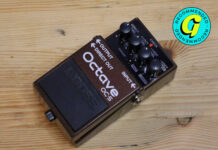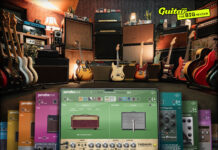
Beatie Wolfe: “We’re so privileged in the way we can have anything. That needs to be challenged. Guitar companies should lead the way”
Many musicians brand themselves as storytellers. But pare back the bluster and their ‘stories’ often amount to little more than music and lyrics. Beatie Wolfe’s work suggests there’s more to it than that. Her stories really do have roots.
READ MORE: The Industry Interview: Taylor Guitars CEO Kurt Listug on the past, present and future of the company
Born in London and based in Los Angeles, Wolfe is an old soul for whom music and ceremony are inextricably linked. Her chamber pop protest songs are propped up by fulsome fingerpicking and smokey vocals, and often backed by lush strings or bolstered by rollicking electric licks. But it’s her curatorial approach to packaging and presentation that makes her records remarkable. Wolfe’s stories begin in the earth and, in some cases, literally reach the stars.
Telling stories
“Music and storytelling go hand in hand,” says the artist and activist from her home and studio in LA. “Discovering my parents’ record collection, I saw them as musical books, portals to other worlds. There was the visual aspect, the experiential aspect, the audio aspect – it was a multisensory experience. When we moved from physical to digital, we lost so much. We lost the ceremony. We lost the tangible component. We lost the story.”
Wolfe’s wistful efforts to claim them back, which typically involve weaving old-fashioned notions with newfangled technologies, have seen her work exhibited at the V&A and SXSW, and featured in the likes of Forbes, New Scientist and Wired. But for the 30-something, these aren’t stunts in service of album sales and press attention. Wolfe’s aim is to reintroduce some much-needed pomp and ceremony back into the act of music appreciation – and, paradoxically, it’s the same tech that gave rise to the modern world’s digital distractions that facilitate her attempts to resist them.
Released as an interactive app that allowed users to simulate the traditional gatefold vinyl experience on their smartphones, Wolfe’s 2013 debut Eight set a precedent. For her follow-up, 2015’s Montagu Square, she paid homage to the storied address at which Paul McCartney wrote Eleanor Rigby, her live recording from the venue translated into a geometric pattern and woven into a smart garment in a canny twist on the idea of the record jacket. For her third album, 2017’s Raw Space, Wolfe led an augmented-reality livestream from one of the quietest rooms on the planet, Bell Labs’ anechoic chamber. Not long later, the album would leave the planet entirely, as it was beamed into space using the Labs’ historic horn antenna.
Every act, every album, has its ceremony. But there is narrative not just in Wolfe’s music and its presentation but also in the tools with which she creates it. One of the stories closest to Wolfe’s heart is that of her Taylor 110e.
By the age of 18, Wolfe had already been writing music for 10 years. But she’d yet to buy her first steel-string, having learnt to play on a battered Spanish-style guitar that once belonged to her grandmother. Having saved up, the self-taught player found herself on Denmark Street in search of an upgrade.
“I went into Rose Morris and there was a 110e that had a superficial discolouration on the neck,” she says. “It wasn’t a perfect bit of wood. It was imperfect. The guy that owned the store just said, ‘Look, this should be double the price but we have to sell it half-price because of the discolouration’, which I liked anyway. I thought it was far more beautiful and interesting. That was the first guitar I bought myself.”
The Taylor would serve Wolfe well. In fact, it was her exclusive squeeze for about 15 years. “That was my guitar,” she says. “I was set on only ever playing with that. It has a lot of blood on the inside from when I was doing my bad accenting-the-upstroke strumming and my fingers would be bleeding. That’s not particularly rock ’n’ roll or anything but the fact that it has blood and these dents, and the places I’ve played with it, it really felt part of me.”
Wolfe’s collection remains relatively small even today. There’s her first electric, a Fiesta Red Fender Stratocaster picked up at London’s New Kings Road Vintage Guitar Emporium, as well a 2017 Gibson Les Paul Classic T Goldtop, with which she summoned the righteous tone on Raw Space cut Pure Being. Then, alongside her Taylor 110e, there’s a Builder’s Edition 324ce and a GT Urban Ash, which lead us to our next story: Taylor’s urban wood initiative.
Wolfe with her Taylor Builder’s Edition 324ce at West Coast Arborists’ shamel ash inventory in Anaheim. Image: Ross Harris
Dead wood
In an effort to combat the ever-deepening tonewood crisis, Taylor hooked up with Anaheim outfit West Coast Arborists in 2017, with an eye towards giving the arborists’ inventory a more musical future. WCA is tasked with maintaining many of California’s urban trees. Those planted in the mid-1900s and now nearing the end of their life cycles would ordinarily be turned into mulch or burned. Instead, the collaboration sees Taylor using WCA’s stocks of shamel ash to produce musical instruments. In 2020, the first fruits of this partnership were unveiled: the Builder’s Edition 324ce. Given Wolfe’s affinity for Taylor, she quickly became an ambassador for the maker’s efforts.
“It happened in a very natural way,” says Wolfe. “The first guitar I bought was a Taylor. That was the guitar I really connected with. Bob Taylor and I connected fairly recently and got to chat. Sometimes you have an affinity for something and you don’t necessarily know why. Then, after you have a conversation with that person or learn more about that company or initiative, you’re like, ‘Oh, that’s why it always felt good to me’. Bob has always been leading the way with reforestation and being conscious about guitars not having an impact environmentally, and being able to reset or address that. As a wider team, they started learning more about my work. It was more about the stories and the projects than me as ‘a Taylor player’.”
Sometimes hundreds of years long, these stories differ from tree to tree. When a tree’s timber is used in the construction of a guitar, its story is extended. When a guitar is sold on or passed between family members, that story is enriched. Through its urban wood initiative, Taylor is giving California’s city trees an unexpected coda. During her visit to the company’s El Cajon factory in 2019, Wolfe’s 110e was given a coda too.
“The 110e that I’d played for 15 years hadn’t necessarily had a lot of love,” she says. “When I went down to the factory in El Cajon, they actually did a full reconstruction on the guitar, and it ended up being done in the same room that it was built. It wasn’t planned. They just traced what part of the factory that model would’ve been made. There was something really lovely about it getting rebuilt in the place it was built to begin with.”
Taylor working on Wolfe’s 110e in the same room it was originally built. Image: Taylor Guitars
As for what Wolfe reckons to Taylor’s Urban Ash guitars, she doesn’t hear much between them and the company’s mahogany instruments – but that’s kind of the point.
“Honestly, I don’t really analyse. But I was surprised at the tone. It does sound very similar to mahogany. It’s almost like you can’t tell the difference. It was more about the story, the reason you would have a guitar like that to begin with. To have something that’s been sourced from city trees, that’s why I got excited about it. The Taylor ethos has been something I connect with. It’s like, lead with the story and the why, and then if it isn’t doing anything dramatically different either way, then why not?”
Inconvenient truths
For Wolfe, the why can be traced back to a single moment: when she saw Al Gore’s 2006 climate-crisis documentary An Inconvenient Truth, which inspired her not only to write new music but to take up environmental activism and make significant changes to the way she lived.
“It really shook me. It was one of those moments in my life where I was like, ‘What the fuck?!’,” she says. “After that, everything changed.” Wolfe made efforts to limit her environmental impact – a large part of the reason that she stuck with only her 110e for so many years.
“By chatting with Bob a couple of years ago, I became much more conscious of the devastation [in the guitar industry],” she says. “Even thinking about the neck of the 110e and how that meant that the guitar was half-price – it was lucky it was even half-price because a lot of the time, if you don’t get this perfectly uniform, monochrome piece of wood, it would just be disposed of. That idea of the aesthetic aspects of a guitar being so environmentally impactful was a big reason I got involved with the Urban Ash. I was amazed we hadn’t been thinking about that for longer.”
Myth and marketing present a massive hurdle for eco-minded guitar makers, with companies such as Taylor continually combating the notion that the perfect tone is only available through old-growth Brazilian rosewood or Honduran mahogany. But dwindling supplies of tonewoods aren’t the only environmental issues facing the industry today. Animal glues, abalone, gut strings, they all have an impact. Does Wolfe think it’s possible to create an entirely sustainable mass-produced guitar?
“Absolutely,” she says. “The Urban Ash is already a good portion of the way there. When you become aware of something, it’s hard to become unaware of it. But it takes so much to provoke or activate that. So much of it is marketing. But ultimately it’s got to come down to the bigger-picture stuff. We have to realise that we can’t continue to live in the way we’ve been living, and that limitations are wonderful.
“We’re so privileged in the way we can have anything at any point. That needs to be challenged. I think guitar companies should be leading the way. Rather than giving people what they want, it should be like, ‘No, we’re going to give you this, because you don’t know what you’re asking for and you probably wouldn’t be able to tell the difference if we didn’t tell you’.”
From green to red
On show at this year’s London Design Biennale, Wolfe’s latest project makes clear another inconvenient truth in the story of the planet. An interactive large-scale projection that uses NASA data to chart the human impact on the planet via the escalating CO2 levels in its atmosphere, From Green To Red is set to a track of the same name first featured on Wolfe’s second album.
She wrote the song in 2006, the same night she saw Al Gore’s documentary. But it would be years before she recorded it. “I thought it would be an irrelevant topic,” she says. “I thought, ‘Well, everyone’s going to see this documentary and we’re going to be on a totally different path. Obviously that didn’t happen.”
The seeds of this environmental protest piece were sown two years ago. Introduced by a NASA engineer to the agency’s atmospheric CO2 graphs, which date back 800,000 years, Wolfe felt another shock to her system. “It was the same moment of like, ‘What the fuck?!’ as seeing An Inconvenient Truth,” she says, still bewildered. “How have we got to this point?”
Wolfe’s intention is to take NASA’s cold, hard data and, by setting it to music and making it interactive, ensure that it is tangible, relatable and, yes, ceremonial. If From Green To Red seems to lack the levity of Wolfe’s past projects, that’s by design.
“With the other album experiences, it was much more playful,” she says. “There was more of a conversation to have about some of those installations. But I hope this just provokes awareness.” Wolfe isn’t playing around anymore. From Green To Red is a wake-up call: if we’re going to extend the story of our planet, we have work to do.
See From Green to Red at the London Design Biennale until June 27 here.
The post Beatie Wolfe: “We’re so privileged in the way we can have anything. That needs to be challenged. Guitar companies should lead the way” appeared first on Guitar.com | All Things Guitar.
Source: www.guitar-bass.net












